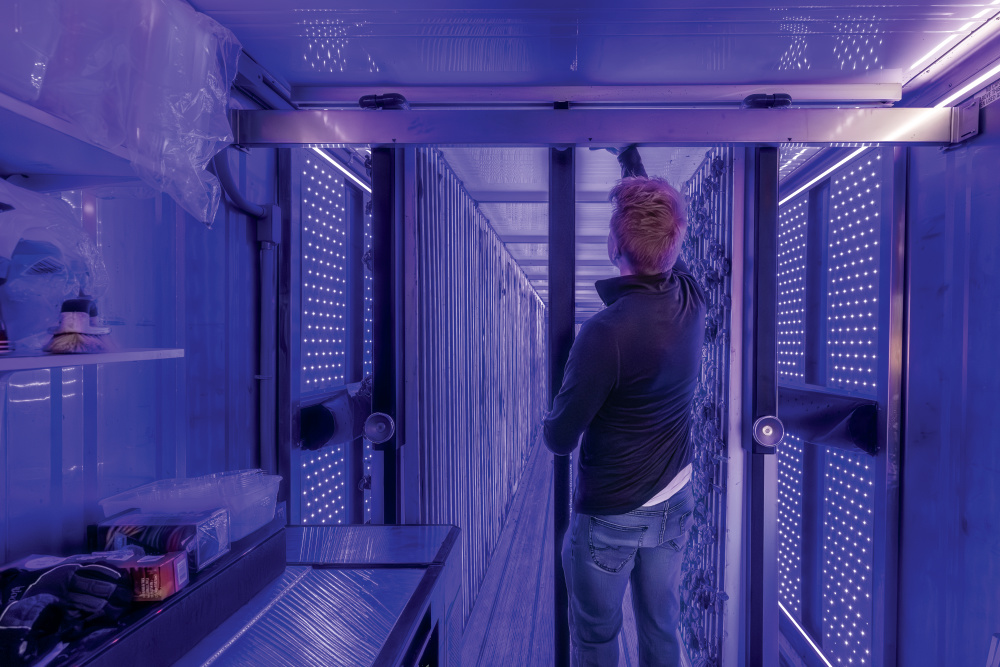Home > North Dakota > North Dakota Crops & Livestock > Vertical Farming Takes Root at Great Plains Greens in North Dakota
Vertical Farming Takes Root at Great Plains Greens in North Dakota
In partnership with: North Dakota Department of Agriculture

When college buddies Dylan Kallman, Jon Wyffels and Lee Vetsch graduated from North Dakota State University and began their careers, they knew they shared a friendship, an entrepreneurial spirit and a passion for agriculture. But they weren’t sure where those commonalities would take them.
The innovative trio was troubled by the fact that their home state is known for livestock and row crops but can often become a fresh food desert.
“We paid attention to the needs of the Fargo-Moorhead community, and vertical growing came to mind,” Vetsch says. “It was a solution the area could use and complementary to what the state was already doing agriculturally.”
See more: Pride of Dakota Helps Catapult Companies Like Dot’s Pretzels to Big-Time Accomplishments
Inside the Box
“North Dakota imports 95% of our fresh produce from California, Arizona and Mexico in the winter,” Kallman says. “Vertical growing helps diversify North Dakota agriculture, and this option was less intensive than buying a whole farm.”
Vetsch is the one who came across the investment opportunity to purchase a 40-by-9-foot retrofitted shipping container, which they utilize to grow produce indoors using hydroponic practices.
However, it is Kallman who remains on the farm in Fargo day to day, overseeing the business. Vetsch and Wyffels come up to help on-site as they can, and Wyffels helps run social media while Vetsch handles some of the accounting.
Great Plains Greens (GPG) grows and supplies fresh leafy greens across the Fargo-Moorhead metro. The fully controlled environment allows them to supply fresh produce 365 days a year while simultaneously locating their farm near the consumer. Because of the technology and infrastructure, they utilize zero pesticides and 99% less water than traditional growing.
See more: North Dakota Soybeans Processing Plants Increase Opportunities

Pride of Dakota
A grant from the Agricultural Products Utilization Commission helped the fellows kick off their entrepreneurial venture.
“This was something completely different for them,” Wyffels says. “They took a chance on us, and we owe credit to them for that.”
GPG is proud to represent the Pride of Dakota (POD) brand, which helps them be recognized in new markets. What makes wearing the POD stamp even better is that the owners know they’re not stealing market share from other farmers but rather creating a new market.
“It is winter for half the year in North Dakota, and farmers have a very small growing window,” says Katie Huizenga, North Dakota Department of Agriculture POD specialist. “Great Plains Greens is able to harvest year-round, so a restaurant can have access to fresh lettuce or produce year-round.”
Seventy percent of their crop is a lettuce variety and depending on how the farm is organized, GPG can harvest 880 heads of lettuce each week.
“We also have cut leaf lettuce/spring mix and in that case, the head will stay on there and continue to grow,” Vetsch says.
In March 2023, the first heads of lettuce were harvested. Initially, GPG sold bulk wholesale to restaurants but recently has been working with the Red River Harvest Cooperative with an online e-commerce platform to sell directly to consumers.
See more: New USDA Grant Helps Feed Hungry North Dakotans and Supports Ag Producers

Additional Growth
GPG has also trialed many herbs such as basil, cilantro, thyme, oregano and rosemary, and they unanimously agree that growing niche crops has been the most interesting.
“You can always find lettuce if you need it, but one crop you can’t find and is hard to source, is basil,” Kallman says. “Basil is a very fragile crop and has a shorter shelf life, and people are always amazed we can grow it so well here in Dakota.”
While they’re still mastering their farming knowledge using one shipping container, GPG knows once that knowledge is secure, they can scale the concept to other containers.
“In our case, the environment is completely the same,” Vetsch says. “We know with strong certainty what our productivity is going to be, which makes it easy to have those conversations with customers about how and when to add containers.”
See more: North Dakota State University Research Uses Bees to Prevent Disease in Sunflowers



